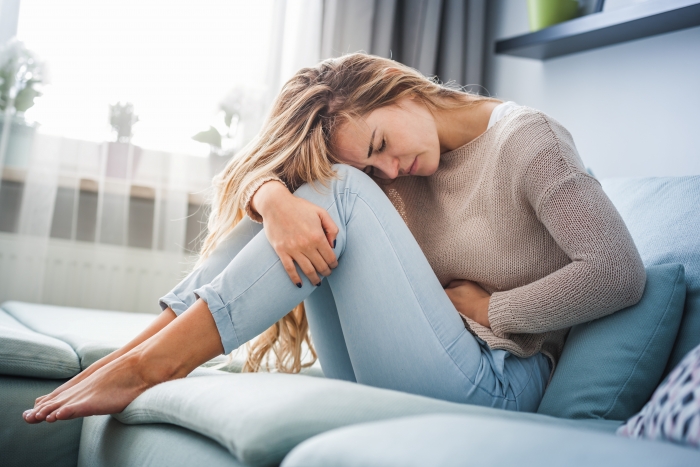Most women are familiar with the pain and cramping associated with menstrual periods. However, the severity of period pain can vary greatly on an individual basis. Some women experience mild discomfort that is easily managed, while others have pain severe enough to interfere with everyday activities during the menstrual cycle each month. Painful periods may be caused by several factors. Depending on how bad the symptoms are and what is causing them, your gynecologist can help you manage the pain.
Causes of Painful Periods
Period pain, medically referred to as dysmenorrhea, is separated into two categories: primary and secondary.
Primary Dysmenorrhea
Primary dysmenorrhea is pain that is caused exclusively by the menstrual period. Dysmenorrhea is described as throbbing or cramping pain in the lower abdomen or pelvic area. Cramps are caused by the uterus contracting to help expel its lining, which is the purpose of menstruation. These contractions are triggered by prostaglandins, a hormone-like substance. Higher levels of prostaglandins are linked to inflammation and more severe dysmenorrhea.
Secondary Dysmenorrhea
Secondary dysmenorrhea is caused by another condition in the reproductive system. Some conditions that cause secondary period pain include:
- Endometriosis: Endometriosis is a condition in which tissue similar to the lining of the uterus grows outside of the uterus. It is a common health issue, and according to the US Office on Women’s Health, endometriosis may affect more than 11% of American women between the ages of 15 and 44. The primary symptom of endometriosis is pain, including severe menstrual cramps that may worsen as the disease progresses. Endometriosis also causes pain in the lower back, pelvis, and intestines. It is also one of the most common causes of infertility in women of reproductive age in the US.
- Adenomyosis: Although it is much rarer than endometriosis, adenomyosis is also a disorder involving the uterine lining. In adenomyosis, the uterine lining grows into the muscle of the uterine wall. Symptoms of the condition include prolonged periods with heavy bleeding and pain.
- Polycystic Ovary Syndrome (PCOS): Polycystic ovary syndrome is a hormonal disorder found in many women of reproductive age. According to the CDC, PCOS affects between 6% and 12% of US women of reproductive age. Some women with PCOS have irregular periods, which may be infrequent and/or prolonged. When women with PCOS have a menstrual period, they often experience heavy bleeding, clots, and severe period pain. As with endometriosis, as PCOS progresses, symptoms like period pain will get worse as well. Other symptoms of PCOS include weight gain, fatigue, painful intercourse, excess facial and body hair growth, acne, male-pattern baldness, ovarian cysts, and infertility.
- Uterine Fibroids: Fibroids are noncancerous growths in the uterus. Often, uterine fibroids don’t cause noticeable symptoms. However, the size, location, and the number of fibroids may cause symptoms like heavy, painful periods that last more than a week. Other symptoms include pelvic pressure or pain, frequent urination, backaches, and leg pain.
- Pelvic Inflammatory Disease (PID): Pelvic inflammatory disease is an infection in the uterus, fallopian tubes, or ovaries. PID is usually caused by sexually transmitted bacteria that travel from the vagina into other parts of the reproductive system. The infection causes inflammation. If the infection is present during the menstrual period, cramping and discomfort may be more severe than normal.
- Cervical Stenosis: Cervical stenosis is a rare condition in which the cervix is much smaller or narrower than usual. It can cause menstrual flow to slow, resulting in increased pressure and pain in the uterus.
How Your Gynecologist Can Help
If you are experiencing period pain that interferes with your daily life every month, then you should talk to your gynecologist. They can determine whether your period pain is primary or secondary dysmenorrhea. From there, the gynecologist can prescribe treatment that will help you manage your symptoms.
If your pain is caused by primary dysmenorrhea, or menstrual cramps on their own, the doctor may prescribe medication to relieve pain. Period pain can also be managed with hormonal birth control, which prevents ovulation and reduces the severity of cramps. Birth control can be given orally, by injection, through an implant in the arm, vaginal ring, dermal patches, or intrauterine device (IUD).
If period pain is caused by an underlying condition, your doctor can recommend treatment options based on the specific condition. Conditions like endometriosis and PCOS are also treated with hormonal birth control and pain relievers but further treatment such as other medications or surgery.
—
Raleigh OB/GYN Centre provides state-of-the-art care for gynecologic conditions, including painful periods, endometriosis, bleeding problems, and pelvic pain. If you have concerns about severe period pain or another condition, call (919) 876-8225 to schedule an appointment at one of our convenient locations.


